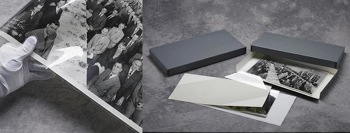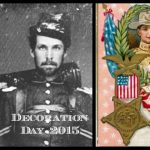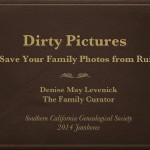
Inter-Church Family Bible Conference Hume Lake Aug. 21-28 1948
Now that you’ve successfully dehumidified all those lovely old documents and long group photos that were held in tightly rolled little batons, you must be looking for a suitable archival-quality storage container. Right?
You will want to store your photos and documents lying flat, and if you have multiple photos or documents it’s a good idea to place a sheet of archival paper between each item.
The best storage choice is an acid-free, lignin-free archival box purchased from a reputable preservation supplier. These companies sell only archival quality products and their biggest customers are libraries, archives, and other institutions.
You may find inexpensive boxes labeled “archival,” but unless the tag also reads “Acid-free” and possibly “Lignin-free,” it is not a true archival product. Confused? You are not alone.
Why “Archival” Is Not Always Archival
Unfortunately, the word “archival” is used freely by manufacturers to describe ANY container intended to store stuff. The word itself has no legal qualification. It’s a bit like the word “organic.”
Remember in the early days of the natural food movement when anyone and everyone called their produce “organic”? In 1990s, the government decided to lay down some ground rules; and today, when you see “certified organic” carrots you can be assured that those orange vegetables meet certain USDA standards.
It’s much the same with archival products. Anyone can call a photo box “archival.” After all, the box may be designed to “archive” or “store” photos. While there may come a time when the industry offers “certified archival” products that meet certain standards, for now, just know that the best storage containers for family keepsakes are labeled as acid-free, lignin-free (or low-lignin) containers.
Where to Find True “Archival” Storage Boxes
I’m often asked where to purchase archival storage boxes, and I have to confess that I’m a great believer in not re-inventing the wheel. When I want to purchase something new, I look for recommendations from people I trust. I feel very comfortable purchasing archival suppliers from the same manufacturer who supplies The Library of Congress and The National Archives. And, I’m not just playing favorites because this same company was kind enough to sponsor my Preserving Keepsakes Workshop at the recent Southern California Genealogical Society Jamboree.
For at least 15 years, my go-to archival supplier has been Hollinger Metal Edge, with locations in Virginia and Southern California. Hollinger offers museum-quality archival products in all shapes and sizes, from photo to document to keepsake storage.
Those long rolled photos we’ve been working with are sometimes called “banquet photos,” presumably because so many images were made of convention and conference banquet attendees. Look for long shallow boxes called “Banquet Photo Storage” or “Group Photo Boxes.” You may have to order in quantities of three or more, so find a friend or someone in your genealogical society who will share an order with you.
Banquet Photo Boxes

Hollinger banquet boxes measure 24 x 12 1/2 x 2-inches and cost under $20 per box. Mylar protective sleeves and archival folders sized to fit individual prints are also available.
Other archival suppliers may offer similar storage boxes; just be careful to purchase true archival-quality containers. Look for acid-free, lignin free boxes.
DIY Options?
You may not want to invest in archival boxes right now; maybe you’d like to find someone to split that order with you. Or, maybe you have only one or two prints and plan to have them framed in the near future.
A DIY archival folder will also protect your newly-flattened print from dust and light. You will need a sheet of heavy-weight archival board, about the weight of good card stock. Simply fold the board in half, and place your print inside. Use scrapbook tape to close the ends and store the folder on a shelf or on top of archival boxes. Be careful not to put items on top of the folder that might cause abrasions on the image, and plan to move the prints to more secure storage as soon as possible.
Archival board is often available at art supply and framing stores. Look for acid-free, lignin-free board.
Where to Store Your Banquet Photo Boxes
Family keepsakes benefit from kind storage. Place your boxes in a location where you live and the temperature is fairly constant — not too hot, or too cold. An empty closet or cupboard in your home is a good spot. Avoid humidity, dust, light, pests, and smoke or fumes.
For more ideas on locating your home archive and preserving different kinds of family treasures, check out my book How to Archive Family Keepsakes: Learn How to Preserve Family Photos, Memorabilia and Genealogy Records .
See Also:
Photo Tutorial: How to Relax and Rehumidify Old Rolled Photographs
Official Disclosure: At my request, Hollinger Metal Edge provided an assortment of archival products for display and demonstration in my workshop at the 2013 SCGS Jamboree. I was not required to promote or endorse their products. I also recieve a small commision through sales at Amazon and Family Tree Books.






Interleavng paper is great for giving items extra protection. I like to use it between the pages in scrapbooks and photo albums too. Thanks for reading, Mariann!
So that's what banquet photos are! I've been feeling really secure putting photos and documents into Hollinger Metal Edge containers, but sometimes I have trouble with the names of their products. Our family photos are now in acid-free lignin-free Whatever of various types, but the full container terminology eludes me.
I bought the "interleaving paper" to separate those small photos that had a little sticky stuff on the back (an unwise former project), which I've put inside envelopes in groups. That paper looks so useful — for separating pages of old scrapbooks, for filing documents . . . seems very safe. I'm going to share all this with my niece and my cousin once removed, who may well get our family "stuff" between them. Thank you for all this good advice and for your book, Denise!